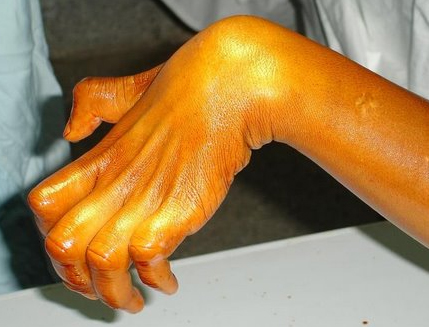What are the symptoms of claw hand?
Claw hand, also known as claw deformity, is a condition where the fingers are bent into a claw-like position, making it difficult to straighten them. The symptoms can vary depending on the underlying cause but generally include:
- Bent fingers: The fingers are bent at the joints, creating a claw-like appearance. This typically involves the last two joints of the fingers being bent towards the palm while the first joint remains extended.
- Muscle weakness: There may be weakness in the muscles of the hand and fingers, making it difficult to perform fine motor tasks.
- Loss of hand function: The ability to grasp, hold, or manipulate objects can be impaired, affecting daily activities.
- Numbness or tingling: There may be a loss of sensation or a tingling feeling in the fingers or hand, often due to nerve damage.
- Pain: Some individuals may experience pain or discomfort in the hand or fingers.
- Muscle wasting: Over time, there can be a loss of muscle mass in the hand, leading to a more pronounced deformity.
- Contractures: The fingers may become permanently bent if the condition is not treated, resulting in fixed contractures.
The exact symptoms can vary depending on the cause of claw hand, which can include nerve injuries (such as ulnar nerve palsy), systemic diseases (such as rheumatoid arthritis), or congenital conditions (such as congenital trigger finger). Treatment often focuses on addressing the underlying cause, which may involve physical therapy, splinting, medications, or surgery.
What are the causes of claw hand?
Claw hand, or claw deformity, can be caused by a variety of factors, including nerve damage, systemic diseases, and congenital conditions. Here are some common causes:
- Ulnar Nerve Palsy: Damage to the ulnar nerve, which controls movement and sensation in the forearm and hand, is a common cause. This can result from trauma, compression, or entrapment of the nerve.
- Leprosy (Hansen’s Disease): This infectious disease can cause nerve damage, leading to muscle weakness and deformities such as claw hand.
- Rheumatoid Arthritis: This autoimmune condition can lead to joint deformities and muscle imbalances in the hands, resulting in claw-like deformities.
- Diabetes: Peripheral neuropathy, a common complication of diabetes, can cause nerve damage and contribute to claw hand.
- Trauma or Injury: Injuries to the hand, wrist, or elbow can damage nerves and muscles, leading to claw hand.
- Congenital Conditions: Some individuals are born with conditions that result in claw hand, such as congenital trigger finger or congenital ulnar nerve abnormalities.
- Charcot-Marie-Tooth Disease: This hereditary neurological disorder affects peripheral nerves and can cause muscle weakness and deformities in the hands and feet.
- Spinal Cord Injuries: Injuries to the spinal cord can disrupt nerve signals to the hands and result in claw hand.
- Stroke: A stroke can cause muscle weakness or paralysis, leading to claw hand if the affected area includes nerves controlling hand muscles.
- Tumors: Tumors in the arm, neck, or spinal cord can compress nerves and cause claw hand.
- Vascular Diseases: Conditions that affect blood flow to the nerves, such as thoracic outlet syndrome, can also cause claw hand.
Treatment for claw hand typically involves addressing the underlying cause, which may include physical therapy, splinting, medications, or surgical interventions to repair or relieve pressure on affected nerves.
What is the treatment for claw hand?
The treatment for claw hand depends on the underlying cause and severity of the condition. Here are some common approaches:
- Physical Therapy: Physical therapy is often a key component of treatment for claw hand. Therapists can provide exercises to strengthen muscles, improve range of motion, and prevent further deformity. They may also teach adaptive techniques to help individuals perform daily activities more easily.
- Splinting: Custom splints or orthotic devices may be prescribed to help support and straighten the fingers and wrist. Splinting can help prevent contractures and maintain proper alignment of the hand.
- Medications: In some cases, medications such as nonsteroidal anti-inflammatory drugs (NSAIDs) or corticosteroids may be prescribed to reduce pain and inflammation associated with certain underlying conditions, such as arthritis or nerve inflammation.
- Nerve Blocks: In cases where nerve compression or irritation is contributing to claw hand, nerve blocks or injections of corticosteroids may be recommended to help alleviate pain and inflammation.
- Surgery: Surgical intervention may be necessary in some cases, particularly if there is significant nerve damage or contracture that cannot be corrected with conservative measures. Surgical procedures may involve releasing tight ligaments or tendons, transferring muscles, or repairing damaged nerves.
- Occupational Therapy: Occupational therapists can help individuals with claw hand learn new ways to perform daily tasks and adapt their environment to better accommodate their needs. They may recommend assistive devices or modifications to help individuals maintain independence and function.
- Lifestyle Modifications: Making modifications to daily activities and routines can help individuals with claw hand manage their condition more effectively. This may include avoiding activities that exacerbate symptoms, using ergonomic tools and equipment, and practicing self-care techniques to manage pain and discomfort.
Treatment for claw hand is typically tailored to the individual based on their specific symptoms, underlying condition, and functional goals. A multidisciplinary approach involving healthcare professionals such as orthopedic surgeons, neurologists, physical therapists, and occupational therapists may be necessary to provide comprehensive care and optimize outcomes.

Leave a Reply
You must be logged in to post a comment.